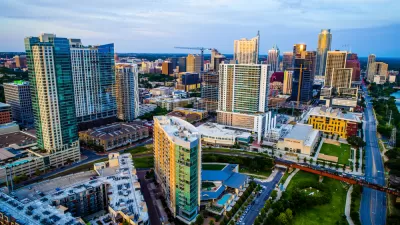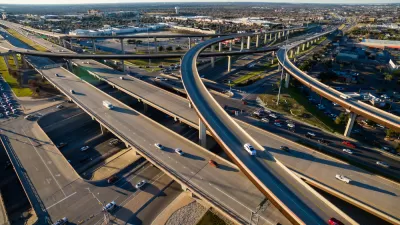The Texas Department of Transportation (TxDOT) wants to spend $4.6 billion to expand Interstate 35 in Austin despite alternative plans proposed by local groups.

"The Texas Department of Transportation this week unveiled its latest proposals to widen the busiest stretch of highway in Central Texas to more than 20 lanes in some areas, significantly increasing Interstate 35's capacity for traffic while engulfing adjacent property," reports Nathan Bernier.
"The $4.9 billion plans — which include adding two non-tolled lanes in each direction, building direct connectors at I-35 and US 290 East, lowering the main lanes and eliminating the upper decks — have already drawn criticism from community groups that have advanced competing proposals to reduce I-35's footprint," adds Bernier.
Planetizen first picked up news about the I-35 Capital Express Central project in November 2020. Since then, a number of groups—including Rethink35, Reconnect Austin, and a partnership between the Downtown Austin Alliance and the Urban Land Institute—have proposed alternatives for the project that would limit some of the impacts of the potential roadway.
According to Bernier, TxDOT enlisted researchers at the Texas A&M Transportation Institute (TTI) to rebuff the proposals generated by those groups. TTI is the same organization that produces the "Urban Mobility Report" cited as authoritative congestion science by local media every year to justify more spending on highway and road expansions.
Experts like Joe Cortright and Todd Litman have repeatedly criticized the research and data practices of TTI—Litman in a blog for Planetizen and Cortright for City Observatory. TxDOT calling on TTI as academic authorities to justify the highway expansion is a political move worth noting.
FULL STORY: TxDOT Slams Brakes On Proposals To Shrink I-35 Footprint

Trump Administration Could Effectively End Housing Voucher Program
Federal officials are eyeing major cuts to the Section 8 program that helps millions of low-income households pay rent.

Planetizen Federal Action Tracker
A weekly monitor of how Trump’s orders and actions are impacting planners and planning in America.

The 120 Year Old Tiny Home Villages That Sheltered San Francisco’s Earthquake Refugees
More than a century ago, San Francisco mobilized to house thousands of residents displaced by the 1906 earthquake. Could their strategy offer a model for the present?

HSR Reaches Key Settlement in Northern California City
The state’s high-speed rail authority reached an agreement with Millbrae, a key city on the train’s proposed route to San Francisco.

Washington State Legislature Passes Parking Reform Bill
A bill that would limit parking requirements for new developments is headed to the governor’s desk.

Missouri Law Would Ban Protections for Housing Voucher Users
A state law seeks to overturn source-of-income discrimination bans passed by several Missouri cities.
Urban Design for Planners 1: Software Tools
This six-course series explores essential urban design concepts using open source software and equips planners with the tools they need to participate fully in the urban design process.
Planning for Universal Design
Learn the tools for implementing Universal Design in planning regulations.
Ada County Highway District
Clanton & Associates, Inc.
Jessamine County Fiscal Court
Institute for Housing and Urban Development Studies (IHS)
City of Grandview
Harvard GSD Executive Education
Toledo-Lucas County Plan Commissions
Salt Lake City
NYU Wagner Graduate School of Public Service





























